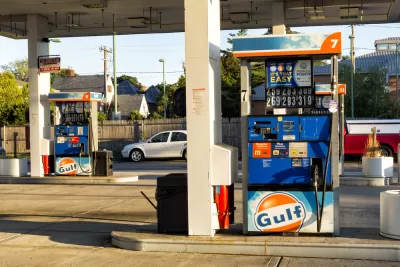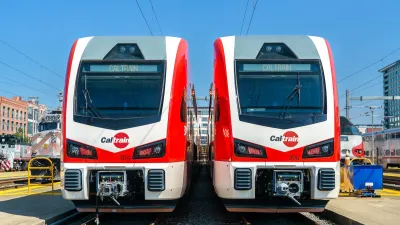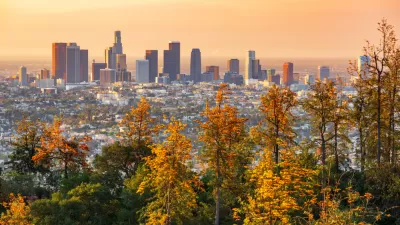The new "50 Steps Toward Carbon-Free Transportation" report examines the gulf between the reality of the U.S. transportation system and the innovations that will be necessary to achieve a carbon-free future.

Tony Dutzik shares new of a new study from the Frontier Group that recommends 50 steps toward carbon-free transportation. The report focuses on the United States, acknowledging that the U.S. transportation system is "Climate Enemy #1."
Dutzik's distillation of the new report includes a lot of quotable facts and illustrative infographics, sure to be of use to those working against the car-centric status quo. For instance, Dutzik includes the following regarding the reality of the U.S. transportation system:
- "Climate change is rarely a factor in transportation decision-making. Only seven states have enforceable, economy-wide limits on carbon pollution, and, as of 2012, the vast majority of states and metropolitan planning organizations did not even consider greenhouse gas emissions in agency planning processes."
- "America spends vastly more on infrastructure for high-carbon modes of travel than low-carbon modes. Between 1956 and 2014, 79 percent of all government capital expenditures on transportation went toward highways, according to Congressional Budget Office data."
- "The federal funding match for new highway projects is generally higher, and the burden of evaluation lower, than major transit capital projects."
Luckily, the report also works from the belief that the United States has the tools to build a carbon-free transportation system, both in policy and in technology. Dutzik lists those tools and explains how each of them can contribute to the cause.
FULL STORY: 50 Steps Toward Carbon-Free Transportation: Rethinking U.S. Transportation Policy to Fight Global Warming

Alabama: Trump Terminates Settlements for Black Communities Harmed By Raw Sewage
Trump deemed the landmark civil rights agreement “illegal DEI and environmental justice policy.”

Planetizen Federal Action Tracker
A weekly monitor of how Trump’s orders and actions are impacting planners and planning in America.

The 120 Year Old Tiny Home Villages That Sheltered San Francisco’s Earthquake Refugees
More than a century ago, San Francisco mobilized to house thousands of residents displaced by the 1906 earthquake. Could their strategy offer a model for the present?

In Both Crashes and Crime, Public Transportation is Far Safer than Driving
Contrary to popular assumptions, public transportation has far lower crash and crime rates than automobile travel. For safer communities, improve and encourage transit travel.

Report: Zoning Reforms Should Complement Nashville’s Ambitious Transit Plan
Without reform, restrictive zoning codes will limit the impact of the city’s planned transit expansion and could exclude some of the residents who depend on transit the most.

Judge Orders Release of Frozen IRA, IIJA Funding
The decision is a victory for environmental groups who charged that freezing funds for critical infrastructure and disaster response programs caused “real and irreparable harm” to communities.
Urban Design for Planners 1: Software Tools
This six-course series explores essential urban design concepts using open source software and equips planners with the tools they need to participate fully in the urban design process.
Planning for Universal Design
Learn the tools for implementing Universal Design in planning regulations.
Clanton & Associates, Inc.
Jessamine County Fiscal Court
Institute for Housing and Urban Development Studies (IHS)
City of Grandview
Harvard GSD Executive Education
Toledo-Lucas County Plan Commissions
Salt Lake City
NYU Wagner Graduate School of Public Service





























